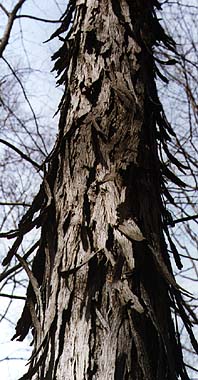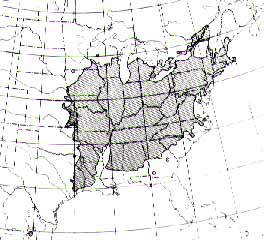Shagbark Hickory --Carya ovata

Shagbark hickory - Carya ovata
Family: Juglandaceae
Form: Medium sized tree, 70 to 80 feet tall
Leaves: Alternate, pinnately compound, 5-7 leaflets, terminal leaflet 5 to 8 inches long, margin finely serrate
Twigs / buds: Stout, gray-brown to reddish brown. Bud ovoid covered with loosely fitting scales,fiving a shaggy appearance
Fruit: 1 to 2 inch long subglobose nut enclosed in a dehiscent husk
Bark: Gray, breaks up into thin vertical strips which are unnattached at ends and curve away from trunk
Range

![]()
Shagbark Hickory (Carya ovata)
Family: Walnut (Juglandaceae)
Flowering: April-May.
Field Marks: This hickory differs from all others by its shaggy bark and usually 5 leaflets per leaf.
Habitat: Woods, both moist and dry, along streams.
Habit: Tree up to 80 feet tall, with a rounded crown.
Bark: Gray, separating into long, shreddy scales, giving the trunk a shaggy appearance.
Leaves: Alternate, pinnately compound, with 5, or sometimes 7 leaflets; the leaflets ovate or obovate, tapering to a short point at the tip, tapering to the base, finely toothed, smooth or hairy, up to 10 inches long, and up to 5 inches broad.
Flowers: Male and female flowers borne separately but on the same plant, appearing after the leaves have begun to unfold; the male flowers in slender, drooping spikes; the female flowers in clusters of 2-5.
Sepals: 4, minute.
Petals: 0.
Stamens: 3-10.
Pistils: Styles usually 4.
Fruits: Usually spherical, up to 2 inches across; the husk yellow-green to red-brown, up to 1/2 inch thick, splitting all the way to the base; the nut 4-angled.
Notes: The kernels of the nuts are extremely tasty.
![]()
Aaron, Jason and Richard planted 5 of these in the 05/97.
6-12 in. trees (not including taproot)...I paid $6.50 each
These are seedlings of an extremely cold-hardy local shagbark from the Ashworth plantings. The nuts fill well, are sweet and have relatively thin shells. Hickories put most of their beginning growth into their very substantial taproot, so many of these have a longer root than top!
I planted four more in Spring of 1998
![]()
![]()
![]()
 Wildflower
Seed For Sale
Wildflower
Seed For Sale